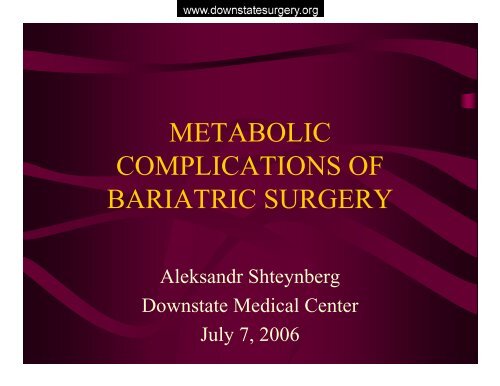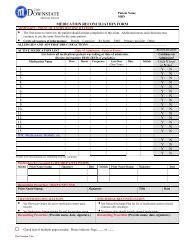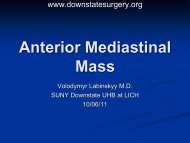metabolic complications of bariatric surgery - Department of Surgery ...
metabolic complications of bariatric surgery - Department of Surgery ...
metabolic complications of bariatric surgery - Department of Surgery ...
You also want an ePaper? Increase the reach of your titles
YUMPU automatically turns print PDFs into web optimized ePapers that Google loves.
METABOLIC<br />
COMPLICATIONS OF<br />
BARIATRIC SURGERY<br />
Aleksandr Shteynberg<br />
Downstate Medical Center<br />
July 7, 2006
Case presentation<br />
• 55 year old female was transferred to<br />
Downstate Medical Center on March 31,<br />
2006 for management <strong>of</strong> <strong>metabolic</strong><br />
encephalopathy and pancreatitis following<br />
gastric bypass procedure performed in<br />
January 2006
Case presentation<br />
•HPI:<br />
– Nausea, vomiting and RUQ pain x 3 days<br />
– Altered mental status: disoriented x 10 days<br />
– Patient was not compliant with medications and<br />
medical follow up<br />
– Patient was treated in referring hospital for<br />
pancreatitis and encephalopathy
Case presentation<br />
• PMH:<br />
– Morbid obesity<br />
– Pancreatitis<br />
– Cholelythiasis<br />
– Hypertension<br />
–DM<br />
– Sleep apnea<br />
– Hyperlipedemia<br />
– Osteoarthritis
Case presentation<br />
• PSH:<br />
– Gastric bypass (January 2006)<br />
• All:<br />
–NKA<br />
• Meds:<br />
– Metochlopramide<br />
– Roxicet<br />
– Protonix<br />
– Amitriptyline
Case presentation<br />
• Vital Signs<br />
– T = 97.3<br />
– B/P = 116/73<br />
– Pulse = 79<br />
• PE significant findings<br />
– Lethargic, confused, impaired short term memory<br />
– No neurological deficits<br />
– Morbid obesity
Case presentation<br />
• Labs:<br />
12 144 114 24 173<br />
7.3 283 4.5 18 1.1<br />
37<br />
– Ca = 9, Mg = 1.6, P = 3<br />
– Alb = 3.1, AST/ALT = 25/41, AP = 63, TB = 3<br />
– Amy = 134, Lip = 433
Case presentation<br />
• Labs microelements:<br />
– Vit B1 = 22 nmol/L (87-280)<br />
– Vit B6 = 3 ng/ml (2-26)<br />
– Vit B12 = 852 pg/ml (211-911)<br />
– FA = 3.5ng/ml (3-16)<br />
– Zn – 905 mcg/L (580-1060)
Case presentation<br />
• Imaging<br />
– CT head – no acute changes<br />
– CTA chest negative for PE
Case presentation<br />
• Hospital course <strong>complications</strong>:<br />
– RUE DVT, likely secondary to PICC line,<br />
– LGIB due to stercoral ulcer and anticoagulation<br />
– Bacteremia and fungemia<br />
– Renal failure<br />
– Aspiration pneumonitis, intubation<br />
– Sepsis
Case presentation<br />
• Treatment<br />
– Vitamin, nutritional supplements<br />
– ICU management for respiratory, renal and<br />
septic <strong>complications</strong>
BARIATRIC SURGERY<br />
AND<br />
POSTOPERATIVE<br />
METABOLIC<br />
COMPLICATIONS
Obesity Epidemic<br />
• 2004 – 20 million morbidly obese Americans<br />
• Percentage <strong>of</strong> obese people in US is the highest in<br />
the world<br />
• BMI <strong>of</strong> obese people in US higher than in Europe<br />
• 35% <strong>of</strong> adolescents in US are obese<br />
• Obesity is the second leading cause <strong>of</strong> preventable<br />
death in the United States after tobacco use<br />
(280 000 deaths per year)
Common Complications <strong>of</strong><br />
Obesity<br />
• Osteoarthritis, joint degeneration – 50%<br />
• HTN – 30%<br />
• Asthma – 25%<br />
• Diabetes – 20%<br />
•GERD–20%
Morbid Obesity<br />
• Definition – Morbid obesity is defined as<br />
being either 100 pounds above ideal body<br />
weight, twice ideal body weight, or having a<br />
body mass index (BMI, measured as weight<br />
in kilograms divided by height in meters<br />
squared) <strong>of</strong> 40 kg/m 2 .
Obesity Classification<br />
• BMI > 25 – overweight<br />
• BMI > 30 – obesity<br />
• BMI > 35 – severe obesity<br />
• BMI > 40 – morbid obesity
Pathophysiology <strong>of</strong> Obesity<br />
• Genetic:<br />
– Leptin receptor (LEPR) gene and melanocortin<br />
4 receptor (MC4R) mutation<br />
• Hormonal disbalance<br />
– CCK and Ghrelin regulate satiety<br />
• Environmental:<br />
– Food availability<br />
– Decreased physical activity
Bariatric <strong>Surgery</strong><br />
• "Baros" greek word meaning weight<br />
• "Iatrike" meaning treatment<br />
• 1889 by an OB/GYN surgeon at John’s<br />
Hopkins, who performed lipectomies on<br />
women during routine surgical procedures<br />
used word <strong>bariatric</strong> <strong>surgery</strong>
History <strong>of</strong> Bariatric <strong>Surgery</strong><br />
• 1895 – Anton Eiselsberg (Billroth’s<br />
student) made a notice <strong>of</strong> weight loss<br />
in patients after gastric or small bowel<br />
resection<br />
• 1950’s Jejunoilieal Bypass the first Bariatric<br />
procedure was presented to a peer reviewed<br />
surgical society.
History <strong>of</strong> Bariatric <strong>Surgery</strong><br />
• Malabsorbtive procedured – 1 st generation<br />
– 1953: Varco et al described Jejunoileal Bypass<br />
• Excellent weight loss<br />
• Complications:<br />
– Gas bloat syndrome<br />
– Diarrhea<br />
– Electrolyte imbalance<br />
– Hepatic fibrosis and failure<br />
– Nephrolithiasis<br />
– Cutaneous eruption<br />
– Impaired mentation
History <strong>of</strong> Bariatric <strong>Surgery</strong><br />
• Malabsorbtive procedures – 2 nd generation<br />
– 1970s: Biliopancreatic diversion (BPD)<br />
• Nicola Scopinaro<br />
– 1990s: Duodenal switch<br />
– No segment <strong>of</strong> intestine left without flow<br />
• Biliary limb<br />
• Enteric limb<br />
• Common channel
History <strong>of</strong> Bariatric <strong>Surgery</strong><br />
• Biliopancreatic diversion (BPD)<br />
– Partial horizontal<br />
gastrectomy<br />
– Closure <strong>of</strong> duodenal<br />
stamp<br />
– Gastrojejunostomy<br />
with long Roux limb<br />
– Enteric anastomosis 50<br />
cm from ileocecal<br />
valve
History <strong>of</strong> Bariatric <strong>Surgery</strong><br />
• Biliopancreatic diversion (BPD)<br />
– IEWL (initial excess weight loss)at 1 yr – 70%<br />
– Maintained for 20 yrs<br />
– Complications:<br />
• Diarrhea<br />
• Flatulence<br />
• Anemia<br />
• Stomal ulcer<br />
• Bone demineralization<br />
• Protein malabsorption
History <strong>of</strong> Bariatric <strong>Surgery</strong><br />
• Duodenal switch introduced by Marceau<br />
– Lesser curvature gastric tube<br />
– Vertical resection <strong>of</strong> 2/3 <strong>of</strong><br />
the stomach<br />
– Preserving pylorus<br />
– Anastomosing enteric limb<br />
to proximal duodenum<br />
– Cross-stapling the distal<br />
duodenum with division<br />
– Common channel 100 cm
History <strong>of</strong> Bariatric <strong>Surgery</strong><br />
• Duodenal switch<br />
– IEML at 18 mo – 80%<br />
– Complications<br />
• Flatulence<br />
• Malodorous stools<br />
• Iron and calcium malabsorption
History <strong>of</strong> Bariatric <strong>Surgery</strong><br />
• Malabsorptive/restrictive procedures<br />
– 1960: combination <strong>of</strong> malabsorption and<br />
restriction elements<br />
– 1966: Mason and Ito introduced Gastric Bypass<br />
(GB)<br />
– 1977: Griffen published results <strong>of</strong> Roux<br />
modification
History <strong>of</strong> Bariatric <strong>Surgery</strong><br />
• Malabsorptive/restrictive procedures<br />
–GB<br />
• Restrictive element<br />
– 30 ml gastric pouch<br />
• Malabsorptive element<br />
– Jejunal loop reconstruction<br />
– Roux limb gastrojejunostomy
History <strong>of</strong> Bariatric <strong>Surgery</strong><br />
• Malabsorptive/restrictive procedures<br />
– Long limb GB<br />
• Roux limb 150 cm (vs. standard 75 cm)<br />
• Used for super obese patients (>= 200 lbs<br />
overweight)<br />
• IEWL 64% at 24 mo
History <strong>of</strong> Bariatric <strong>Surgery</strong><br />
• Malabsorptive/restrictive procedures<br />
– Laparoscopic GB<br />
• Most common laparoscopic <strong>bariatric</strong> <strong>surgery</strong> in US<br />
• IEWL 80% at 1 year
History <strong>of</strong> Bariatric <strong>Surgery</strong><br />
• GB: laparoscopic vs. open<br />
Nguyen et al., Laparoscopic vs. open gastric bypass. Ann Surg 232 (2000), pp. 515-529.
History <strong>of</strong> Bariatric <strong>Surgery</strong><br />
• Restrictive procedures<br />
– 1971: Mason and Printen performed first<br />
gastroplasty<br />
• Horizontal gastric division<br />
• Greater curvature conduit<br />
– 1980: Mason:<br />
• Vertical gastroplasty with Marlex<br />
mesh around outlet channel
History <strong>of</strong> Bariatric <strong>Surgery</strong><br />
• Restrictive procedures<br />
– 1981: Fabito<br />
•1 st stapled vertical banded<br />
gastroplasty<br />
– 1994: Hess and Hess<br />
• Laparoscopic vertical banded<br />
gastroplasty
History <strong>of</strong> Bariatric <strong>Surgery</strong><br />
• Restrictive procedures<br />
– 1978: Wilkinson and Peloso<br />
• Gastric banding<br />
– 1986: Kusmak<br />
• Inflatable band with<br />
subcutaneous port
History <strong>of</strong> Bariatric <strong>Surgery</strong><br />
• Restrictive procedures<br />
– 1993: Forsell<br />
• Laparoscopic placement<br />
<strong>of</strong> adjustable gastric band
History <strong>of</strong> Bariatric <strong>Surgery</strong><br />
• Gastric banding<br />
– Italian Collaborative Study Group (2001)<br />
• 5 year experience with 1,265 patients<br />
• BMI reduction 30.8% at 2 years<br />
• Operative mortality – 0.55%<br />
• Conversion rate – 1.7%<br />
• Pouch dilation 5.2%<br />
• Band erosion 1.9%
History <strong>of</strong> Bariatric <strong>Surgery</strong><br />
• Other procedures<br />
– Stereotaxic stimulation <strong>of</strong> sites in lateral<br />
hypothalamus (Quaade at el, 1974)<br />
– Gastric and vagal pacing<br />
• Preliminary human trials<br />
• Device reduces circulating levels <strong>of</strong> cholecystokinin,<br />
somatostatin, GLP-1, and leptin
Indications for <strong>bariatric</strong> <strong>surgery</strong><br />
• BMI > 40 kg/m 2 or BMI > 35 kg/m 2 with<br />
associated medical comorbidity exacerbated by<br />
obesity<br />
• Failed dietary therapy<br />
• Psychiatrically stable<br />
• Knowledgeable about operation and its sequelae<br />
• Motivated<br />
• Medical problems do not preclude likely survival<br />
from <strong>surgery</strong>
Contraindication for <strong>bariatric</strong><br />
<strong>surgery</strong><br />
• Active substance abuse<br />
• Noncompliance with previous medical care<br />
• Active peptic ulcer disease
Metabolic Complications<br />
•Anemia<br />
• Vitamin B12 deficiency<br />
• Folate deficiency<br />
• Iron deficiency<br />
• Vitamin D deficiency<br />
• Wernicke’s encephalopathy<br />
• Vitamin A deficiency
Metabolic Complications <strong>of</strong> Different Bariatric Procedures<br />
VBG,<br />
gastric<br />
banding<br />
Gastric bypass<br />
BPD<br />
Excess body weight<br />
lost<br />
40%–50%<br />
65%–75%<br />
70%–80%<br />
Protein malnutrition<br />
No<br />
Rare<br />
Yes<br />
Anemia<br />
No<br />
Yes<br />
Yes<br />
Vitamin deficiency<br />
No<br />
Yes<br />
Yes<br />
Iron deficiency<br />
No<br />
Yes<br />
Yes<br />
Calcium deficiency<br />
No<br />
No<br />
Yes<br />
Follow-up labs<br />
None<br />
CBC, iron<br />
studies, B12,<br />
folate<br />
CBC, iron studies, B12, folate,<br />
albumin, electrolytes, fatsoluble<br />
vitamins, PTH, INR<br />
Standard<br />
supplements<br />
None<br />
Multivitamin,<br />
iron<br />
Multivitamin, iron, calcium,<br />
vitamins A and D
Anemia<br />
• 36.8 % (post GB)<br />
• 3.5% require transfusion<br />
• Iron deficiency 20-49%<br />
– Decreased stomach acid<br />
– No exposure <strong>of</strong> nutrients to duodenum and proximal<br />
jejunum<br />
• B12 deficiency 26-70%<br />
– Decreased intake<br />
– Diminished intrinsic factor secretion<br />
• Folate deficiency 9-35%
Anemia<br />
• Prevention<br />
– Folate deficiency<br />
•MVI<br />
• Higher doses for reproductive age women<br />
–B12<br />
• 350 µg crystalline oral Vit B12<br />
• IM supplementation
Vitamin D deficiency<br />
• Parathyroid axis abnormalities in obese<br />
patients<br />
– Increased PTH and 1,25 hydroxy-vitamin D<br />
– Decreased 25 hydroxy-vitamin D<br />
• After weight loss procedure<br />
– Decreased absorption <strong>of</strong> Ca and Vit D<br />
– Alteration in mechanical load <strong>of</strong> the skeleton
Vitamin D deficiency<br />
• Osteomalatia<br />
– Micr<strong>of</strong>ractures, diffuse bone pain<br />
– Proximal myopathy<br />
• Prevention<br />
– Daily 1200 mg <strong>of</strong> Ca, and 400-800 IU Vit D
Wernicke’s Encephalopathy<br />
• Thiamine (Vit B1) deficiency<br />
– Water soluble vitamin<br />
– Absorbed in small intestine<br />
• By 2005 11 cases reported after GB
Wernicke’s Encephalopathy<br />
• Clinical triad<br />
– Nystagmus and ocular nerve palsies<br />
–Ataxia<br />
– Apathetic mental confusion<br />
• MRI findings<br />
– Injury to mamillary body<br />
• Treatment<br />
– Thiamine 100 mg Q8 hr
Vitamin A deficiency<br />
• Reported only after BPD<br />
• 69% by 4 years after <strong>surgery</strong><br />
• Occasionally symptomatic<br />
• Resolution <strong>of</strong> symptoms after<br />
supplementation
Metabolic Complications<br />
• Recommendations for prevention<br />
– Outpatient semi-annual follow-up<br />
• Serum iron<br />
•Hct<br />
• 25 hydroxy-vitamin D<br />
• Parathyroid hormone<br />
•VitB12<br />
•VitA
Metabolic Complications<br />
• Recommendations for prevention<br />
– Supplements<br />
•MVI<br />
• Folate 400 µg<br />
• Vit B12 350 µg<br />
• Ca 1500 mg<br />
• 25 hydroxy-vitamin D 800-1000 IU<br />
• Thiamine parenterally for patients with poor intake
Future <strong>of</strong> Bariatric <strong>Surgery</strong><br />
• An algorithm is needed<br />
– for selecting the most appropriate operation for<br />
a given patient<br />
– to take into consideration<br />
•Weight<br />
•Age<br />
• Gender<br />
• Comorbidities<br />
• Race<br />
• Nationality<br />
•Outcomes expectations<br />
•Body habitus<br />
•Operative safety<br />
•Side effects<br />
•Long-term <strong>complications</strong>.
Summary<br />
• Morbid obesity reached epidemic level in<br />
US. Presently <strong>bariatric</strong> <strong>surgery</strong> is the most<br />
effective treatment option available<br />
• Metabolic benefits <strong>of</strong> <strong>bariatric</strong> <strong>surgery</strong><br />
significantly outweigh <strong>complications</strong>.
Summary<br />
• Prevention and early medical intervention<br />
essential to avoid <strong>metabolic</strong> <strong>complications</strong><br />
<strong>of</strong> <strong>bariatric</strong> <strong>surgery</strong><br />
• Integrated medical team care necessary for<br />
the management <strong>of</strong> <strong>bariatric</strong> patient

















